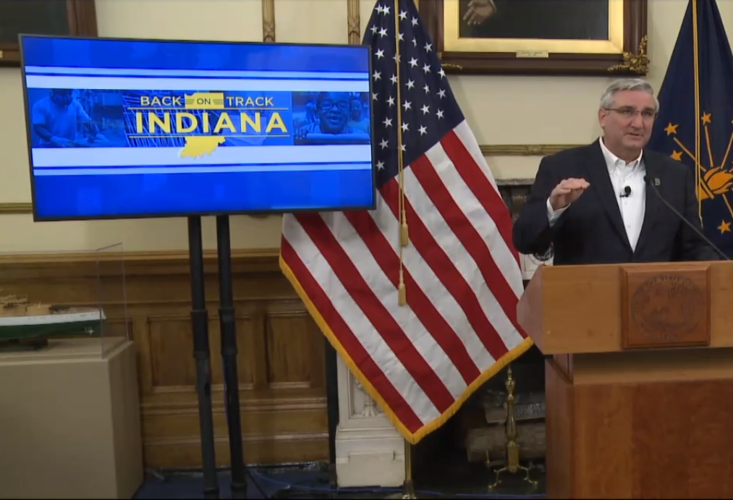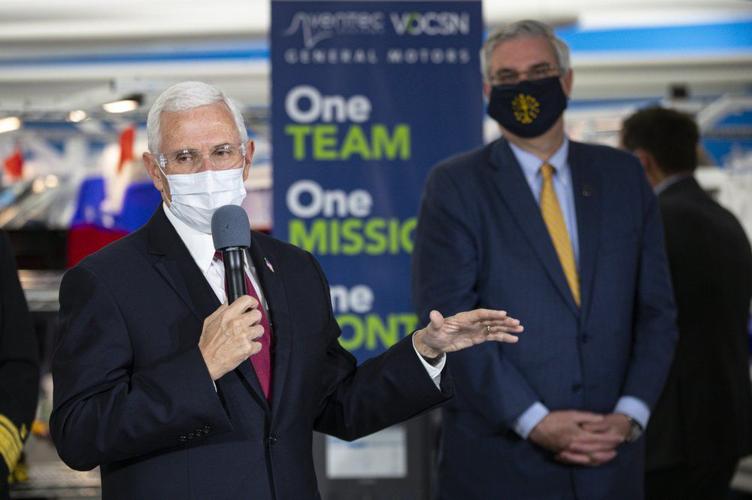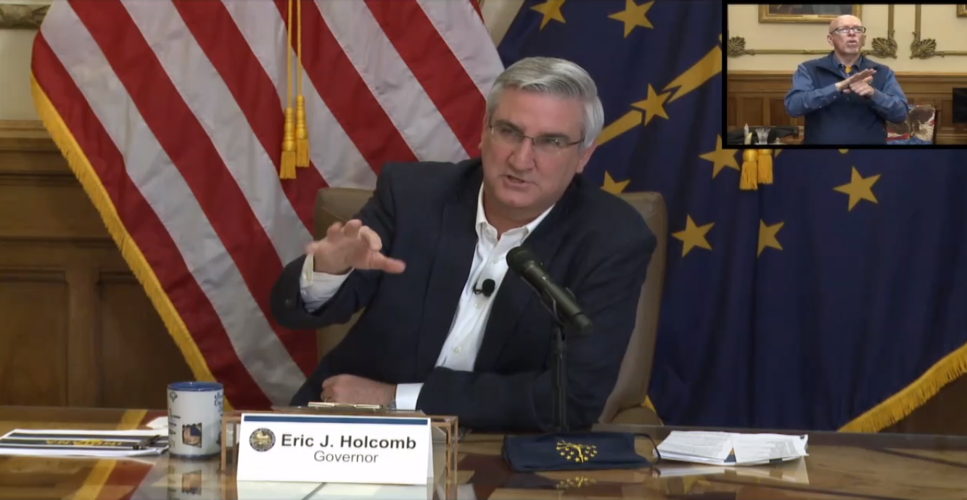LOUISVILLE, Ky. (WDRB) – Indiana Gov. Eric Holcomb on Friday detailed a gradual, five-stage plan to restart businesses and services shuttered by the COVID-19 pandemic and allow increasingly larger social gatherings starting as early as Monday.
Holcomb outlined a phased approach that would let certain sectors resume operations at reduced capacity, easing restrictions every few weeks — on May 24, June 14 and July 4. After the Fourth of July, Indiana would resemble what he has called the "new normal."
Until then, the governor generally recommends continued social distancing and for Hoosiers to wear masks or face coverings in public until at least mid-June. After July 4, the coverings would be optional but still advised in malls, retail stores, commercial businesses, restaurants and bars.
President Donald Trump's roadmap for states to reopen their economies suggested that new cases drop for 14 straight days before taking the first steps. But as testing increases across the country, resulting in new cases, governors like Holcomb and Andy Beshear in Kentucky have stressed other metrics instead.
Holcomb said his "Back on Track" plan is contingent on hospitalizations from the disease continuing to decline; a robust capacity of acute hospital beds and ventilators; widespread testing; and rigorous contact tracing of Hoosiers with COVID-19.
He also cautioned that the reopenings could be delayed or reversed if the data warrants.
“This is a little bit of science and it’s a little bit of art, and I think we’ve got the timing right,” Holcomb said during a briefing in Indianapolis. “… We might have to take a detour. Or we might even have to put it in park.”
Public and private school grounds would stay closed through June 30. Holcomb said officials will make a decision on the next academic school year in July.
Several counties that are COVID-19 hotspots won't start reopening right away. But the rest of the state can begin Monday.
What happens next
Retail and commercial businesses that had been limited to curbside deliveries can begin operating Monday at 50% of their pre-pandemic capacity.
Shopping malls also can open but must be at half-capacity.
Manufacturers and other industrial operations that have been closed can reopen but must follow federal Occupational and Safety Health Administration and Centers for Disease Control and Prevention (CDC) guidance.
For example, those employers must screen their workers daily; use face coverings; take steps to have proper social distancing; and provide workers and customers with COVID-19 policies.
A week later, on May 11, hair salons, tattoo parlors, barber shops and spas can reopen but must take customers by appointment. In addition, those workers must wear face coverings — as should customers.
Also during that week, restaurants and bars that serve food can return to in-person dining at 50% capacity, but servers and kitchen staff would be required to wear masks or face coverings.
Bar seating would remain closed.
During the May 4-May 24 period, bars and nightclubs would stay dark, along with gyms and other community facilities. Sports arenas, concert venues, zoos, casinos and museums are among a number of other places that can't reopen.
Public and private "community" swimming pools would not be open.
Holcomb is encouraging employees to work remotely when possible.
Starting May 4, social gatherings of up to 25 people can take place. But Holcomb says social distancing must occur — even at events like Mother's Day celebrations and birthday parties.
Churches and other religious services can resume May 8, although Holcomb urges anyone 65 and older or with an "at-risk" health condition to stay home.
In fact, even with the changes announced Friday, Holcomb said Hoosiers over 65 and with health conditions should stay home as much as possible.
Further steps
The next phase of reopening would begin May 24.
At that point, gyms and fitness centers would be allowed to operate but with spaced-out equipment and class sizes.
Retailers could expand their businesses by operating at 75% of capacity. Malls also could gradually increase capacity.
Bars and nightclubs would stay closed, but community pools could reopen a day ahead of Memorial Day as long as they followed CDC standards. With social distancing in place, Hoosiers could start using campgrounds once again.
Movie theaters could reopen at half of their typical capacity.
Nursing homes, which have been especially hard hit by COVID-19, would still be closed to visitors. In fact, Holcomb's plan says that even after July 4, officials would continue to evaluate nursing home guidance.
By June 14, social gatherings of up to 250 people could resume, while malls and retailers could return to regular operations.
Bars could reopen at 50% of their capacity, while dining rooms could increase their capacity to 75%.
Softball and other recreational sports leagues could resume in mid-June, and amusement and theme parks could open — at 50% of their capacity and with reservations required to ensure social distancing.
If all goes according to Holcomb's plan, the final phase would start July 4. At that point, most activities would resume at levels resembling normal: There would be no restrictions on capacity at malls, retailers, bars, restaurants, nightclubs, gyms and fitness centers, for example.
Conventions, sports events, festivals and the state fair could resume.
Indiana is among a network of seven states, including Kentucky, whose governors are sharing information on plans to gradually reopen parts of their economies.
Earlier this week, Beshear unveiled his approach to lifting restrictions on Kentucky's businesses, services and gatherings. It includes allowing construction and manufacturing work, car dealerships, dog groomers and horse tracks to reopen starting May 11 if they meet social distancing and other criteria.
Office-based businesses in Kentucky also could resume in-person work with 50% of their pre-pandemic staffing.
But Beshear's initial plan is more conservative than Holcomb's. In Louisville on Friday, Mayor Greg Fischer expressed some reservations about Indiana's approach and said he would work with New Albany Mayor Jeff Gahan and Jeffersonville Mayor Mike Moore.
"They were a little later than us going into their Healthy at Home, and now they are going to be coming out Health at Home sooner," Fischer told reporters, referring to Indiana. "So that potentially could be a problem."
Beshear also urged Kentuckians to remain "healthy at home" and avoid things like dining out in Indiana.
"We can see how that works in Indiana," he said. "We can learn from it and if that means moving up our time table or moving back our time table, but doing that can frustrate the plan that we have and could potentially push back our timeline."
Asked how the restrictions will be enforced, Holcomb said no state has the law enforcement resources to ensure all rules are followed and his plan relies on the good faith of Hoosiers, or restrictions will return.
"If we continue to be responsible, play by the rules and get with the program, then we will stay on track," Holcomb said. "... It will come down to state, local and most importantly, Hoosiers in themselves."
Meanwhile, Indiana reported its second-highest number of new COVID-19 cases Friday.
The Indiana State Department of Health announced 815 new infections of the illness diagnosed between April 16 and Thursday. That was the most since 952 were reported Monday.
However, the increase comes as more testing is being conducted, moving the state closer to its goal more than 6,000 per day. There were 4,660 new tests disclosed Friday, according to state data.
In all, 18,630 Hoosiers have contracted COVID-19, and 1,062 have died, data show. Another 113 deaths are considered "probable" results of the illness caused by the novel coronavirus SARS-CoV-2 because of symptoms, X-rays and CAT scans consistent with the disease.
In southern Indiana, Clark County reported 23 new cases of COVID-19 and now has 316 documented infections. Floyd County had four new cases, data show, taking its total to 182.
There have been 16 coronavirus deaths in each of those counties.
Reporter Chris Otts contributed.
Reach reporter Marcus Green at 502-585-0825, mgreen@wdrb.com, on Twitter or on Facebook. Copyright 2020 WDRB Media. All rights reserved.

















